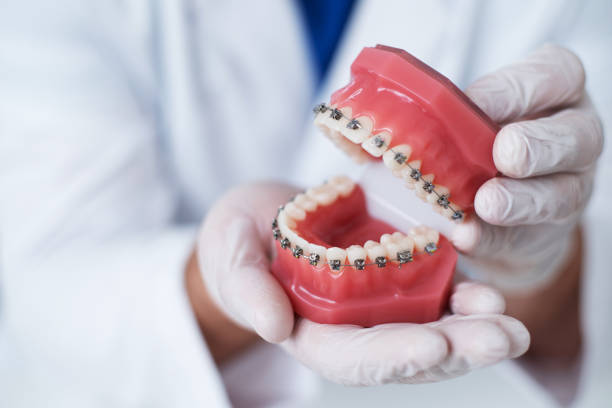
Dental braces are used in orthodontics to align and straighten teeth and help position them with regard to a person's bite, while also aiming to improve dental health. They are often used to correct underbites, as well as malocclusions, overbites, open bites, gaps, deep bites, cross bites, crooked teeth, and various other flaws of the teeth and jaw.
Braces can be either cosmetic or structural. Dental braces are often used in conjunction with other orthodontic appliances to help widen the palate or jaws and to otherwise assist in shaping the teeth and jaws.Many children and teens wear braces, but adult braces are common, too.
· How do braces work?
Braces use mild, constant pressure to shift your teeth into their proper positions over time. The exact way this happens depends on the type of braces you choose.
· What are the types of braces?
There are several different types of braces. The type that’s best for you depends on a few factors, including the kind of issue you have, the severity of your condition and your personal preferences.
Metal braces
When you think of braces, traditional metal braces might be what you imagine. Metal braces use stainless steel bands, brackets and wires to gently shift your teeth over time.
A dentist or orthodontist will bond (glue) a bracket on each tooth, then place a thin, flexible archwire over the brackets. Tiny elastic bands called ligatures keep the wire firmly in place.
Metal braces are visible when you smile. You can choose clear or tooth-colored ligatures to make your braces less noticeable. Or, if you’re feeling festive, you can choose brightly colored ligatures.
Ceramic braces Ceramic braces — sometimes called clear braces — work the same way as metal braces. The key difference is that the brackets, wires and ligatures are tooth-colored, so they blend in with your smile. Ceramic braces are still visible, but they’re less noticeable. One
drawback to ceramic braces is that they’re more fragile than metal braces, so they’re more likely to break.
Lingual braces
Lingual braces are similar to traditional braces. But they go on the back surfaces of your teeth instead of the front. Most people who choose lingual braces do so because they don’t want other people to be able to tell they have braces.
Self-ligating braces
Self-ligating braces look similar to traditional metal braces. The main difference is that, instead of ligatures (tiny elastic bands), self-ligating braces use a built-in system to hold the archwire in place.
· What age is best for braces? You’re never too old for orthodontics. That said, the best time for braces is generally between the ages of 9 and 14. At this point, your jaws and facial bones are more malleable (flexible) because they’re still developing. Adult braces are just as effective, but it might take a little longer to achieve the desired results.
PROCEDURE DETAILS
How long do braces take to work?
The answer to this question is different for everyone. On average, braces treatment takes about two years to complete. But it depends on the severity of misalignment. Some people finish treatment in under 12 months. Others may need as long as three years.
RISKS / BENEFITS
What are the benefits of dental braces?
The most obvious advantage of braces is a straighter, more beautiful smile. But braces can also:
· Make your teeth easier to clean. · Help prevent cavities and gum disease. · Correct temporomandibular joint (TMJ) disorders.
· Restore proper functions like chewing and speaking.
In short, braces can improve the health, function and appearance of your smile.
What are the normal side effects of braces?
There are some mild, expected side effects of braces, including:
· Temporary discomfort (which usually occurs the first day and any time your dentist tightens your braces). · Irritation on your tongue, lips or inner cheeks. · Jaw pain.
· Difficulty eating (especially after a tightening).
You can manage most of these side effects with over-the-counter (OTC) pain relievers. You can also purchase dental wax for braces at your local pharmacy to help with irritation inside your mouth. Simply place some wax over any rough-feeling brackets or wire.
RECOVERY AND OUTLOOK
Do braces hurt?
You’ll likely have discomfort for a few days after you get your braces. Some people experience tenderness after routine tightening, too. But generally, your braces shouldn’t hurt.
How should I care for my braces? Proper oral hygiene is even more important when you wear braces. Plaque and tartar can build up around your brackets and wires, leading to cavities and gingivitis.
We will give you a detailed list of instructions for taking care of your braces. But here are a few general guidelines:
· Brush your teeth at least twice a day using a soft-bristled toothbrush and fluoride toothpaste.
· Floss between your teeth and around your braces once a day. (Ask your dentist or orthodontist about special floss for braces.)
· If you have clear aligners, clean them every day and store them properly when you’re not wearing them.
· Swish with an alcohol-free, antibacterial mouthwash twice a day.
· Avoid hard, crunchy or sticky foods.
· Visit your orthodontist regularly for tightening and maintenance.
· Visit us regularly for cleanings and routine dental care.
How can I maintain my results after braces? Anyone who wears braces will need to wear a teeth retainer when they’re done with treatment. A retainer prevents your teeth from shifting back into their old positions.
There are many types of retainers. We will help choose one that’s right for you.